Film Composition And A Film Prepared Thereby
CHU; Yen-Yi ; et al.
U.S. patent application number 16/593320 was filed with the patent office on 2020-04-09 for film composition and a film prepared thereby. This patent application is currently assigned to Industrial Technology Research Institute. The applicant listed for this patent is Industrial Technology Research Institute. Invention is credited to Hsi-Yi CHIN, Yen-Yi CHU, Chi-En KUAN, Wei-Ta YANG.
| Application Number | 20200109234 16/593320 |
| Document ID | / |
| Family ID | 70051952 |
| Filed Date | 2020-04-09 |



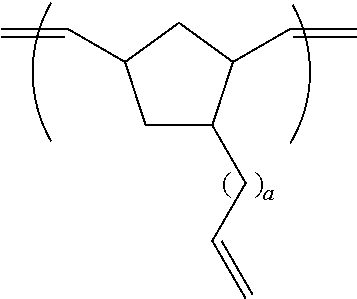







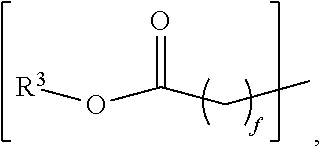
View All Diagrams
| United States Patent Application | 20200109234 |
| Kind Code | A1 |
| CHU; Yen-Yi ; et al. | April 9, 2020 |
FILM COMPOSITION AND A FILM PREPARED THEREBY
Abstract
The disclosure provides a film composition, wherein the film composition includes an oligomer and a crosslinking agent. The oligomer can have a structure represented by Formula (I) ##STR00001## , wherein R.sup.1 and R.sup.2 are independently hydrogen, C.sub.1-20 alkyl group, C.sub.2-20 alkenyl group, C.sub.6-12 aryl group, C.sub.6-12 alkylaryl group, C.sub.5-12 cycloalkyl group, C.sub.6-20 cycloalkylalkyl group, alkoxycarbonyl group, or alkylcarbonyloxy group; R.sup.1 is not hydrogen when R.sup.2 is hydrogen; a is 0 or 1; 100.gtoreq.n.gtoreq.1; 100.gtoreq.m.gtoreq.1; and when n is not 0, the ratio of n to m is from 3:1 to 1:4. The weight ratio of the oligomer and the crosslinking agent can be from 9:1 to 3:7. The oligomer has a number average molecular weight (Mn) from 1,000 to 8,000.
| Inventors: | CHU; Yen-Yi; (Miaoli City, TW) ; CHIN; Hsi-Yi; (Hsinchu City, TW) ; YANG; Wei-Ta; (Taoyuan City, TW) ; KUAN; Chi-En; (Zhudong Township, TW) | ||||||||||
| Applicant: |
|
||||||||||
|---|---|---|---|---|---|---|---|---|---|---|---|
| Assignee: | Industrial Technology Research
Institute Hsinchu TW |
||||||||||
| Family ID: | 70051952 | ||||||||||
| Appl. No.: | 16/593320 | ||||||||||
| Filed: | October 4, 2019 |
Related U.S. Patent Documents
| Application Number | Filing Date | Patent Number | ||
|---|---|---|---|---|
| 62741835 | Oct 5, 2018 | |||
| Current U.S. Class: | 1/1 |
| Current CPC Class: | C09D 165/00 20130101; C08G 2261/1414 20130101; C08F 299/04 20130101; C08K 5/34924 20130101; C08G 2261/592 20130101; C08G 2261/65 20130101; C08L 65/00 20130101; C08G 61/02 20130101; C08G 2261/135 20130101; C08G 61/08 20130101; C08L 2312/00 20130101; C08G 2261/122 20130101; C08G 2261/1426 20130101; C09D 151/003 20130101; C08G 2261/60 20130101; C08L 2203/16 20130101; C08G 2261/1412 20130101; C08G 2261/226 20130101; C08G 2261/3324 20130101; C08F 283/14 20130101; C08F 283/14 20130101; C08F 238/00 20130101 |
| International Class: | C08G 61/02 20060101 C08G061/02; C08L 65/00 20060101 C08L065/00 |
Foreign Application Data
| Date | Code | Application Number |
|---|---|---|
| Sep 30, 2019 | CN | 201910941870.1 |
Claims
1. A film composition, comprising: a crosslinking agent; and an oligomer, wherein the weight ratio of the oligomer to the crosslinking agent is from 9:1 to 3:7, wherein the crosslinking agent is a compound having at least two crosslinkable functional groups or a bismaleimide, wherein the crosslinkable functional group is alkenyl group, methacrylate group, acrylate group, acryloyl group, epoxy group, carboxyl group, or a combination thereof, wherein the oligomer has a number average molecular weight (Mn) from 1,000 to 8,000, wherein the oligomer has a structure represented by Formula (I) ##STR00042## wherein R.sup.1 and R.sup.2 are independently hydrogen, C.sub.1-20 alkyl group, C.sub.2-20 alkenyl group, C.sub.6-12 aryl group, C.sub.6-12 alkylaryl group, C.sub.5-12 cycloalkyl group, C.sub.6-20 cycloalkylalkyl group, alkoxycarbonyl group, or alkylcarbonyloxy group; R.sup.1 is not hydrogen when R.sup.2 is hydrogen; a is 0 or 1; n.gtoreq.0; m.gtoreq.1, and when n is not 0, the ratio of n to m is from 3:1 to 1:4; and the repeat unit ##STR00043## and the repeat unit ##STR00044## are arranged in a random or block fashion.
2. The film composition as claimed in claim 1, wherein R.sup.1 and R.sup.2 are independently hydrogen, or ##STR00045## wherein b is 0, or an integer from 1 to 19; and, R.sup.1 is not hydrogen when R.sup.2 is hydrogen.
3. The film composition as claimed in claim 1, wherein R.sup.1 and R.sup.2 are independently hydrogen, or ##STR00046## wherein c is 0, or an integer from 1 to 6; and, R.sup.1 is not hydrogen when R.sup.2 is hydrogen.
4. The film composition as claimed in claim 1, wherein R.sup.1 and R.sup.2 are independently hydrogen, or ##STR00047## and wherein d is 0, or an integer from 1 to 6; and, R.sup.1 is not hydrogen when R.sup.2 is hydrogen.
5. The film composition as claimed in claim 1, wherein R.sup.1 and R.sup.2 are independently hydrogen, or ##STR00048## wherein e is 0, or an integer from 1 to 6; and, R.sup.1 is not hydrogen when R.sup.2 is hydrogen.
6. The film composition as claimed in claim 1, wherein R.sup.1 and R.sup.2 are independently hydrogen, or ##STR00049## and wherein f is 0, or an integer from 1 to 6; R.sup.3 is C.sub.1-6 alkyl group; and, R.sup.1 is not hydrogen when R.sup.2 is hydrogen.
7. The film composition as claimed in claim 1, wherein R.sup.1 and R.sup.2 are independently hydrogen, or ##STR00050## and wherein g is 0, or an integer from 1 to 6; R.sup.4 is C.sub.1-6 alkyl group; and, R.sup.1 is not hydrogen when R.sup.2 is hydrogen.
8. The film composition as claimed in claim 1, wherein R.sup.1 and R.sup.2 are independently hydrogen, or ##STR00051## wherein h is an integer from 1 to 6; and, R.sup.1 is not hydrogen when R.sup.2 is hydrogen.
9. The film composition as claimed in claim 1, wherein R.sup.1 and R.sup.2 are independently hydrogen, or ##STR00052## wherein i is 0 or an integer from 1 to 6; and, R.sup.1 is not hydrogen when R.sup.2 is hydrogen.
10. The film composition as claimed in claim 1, wherein R.sup.1 and R.sup.2 are independently hydrogen, or ##STR00053## wherein j is 0 or an integer from 1 to 6; and, R.sup.1 is not hydrogen when R.sup.2 is hydrogen.
11. The film composition as claimed in claim 1, further comprising a solvent, wherein the ratio of the weight of the solvent to the total weight of the oligomer and the crosslinking agent is from 0.01 to 60.
12. The film composition as claimed in claim 1, wherein the crosslinking agent is a bismaleimide having a structure represented by Formula (II) or Formula (III) ##STR00054## , wherein R.sup.5 is --CR.sub.2--, --NR--, --C(O)CH.sub.2--, --CH.sub.2OCH.sub.2--, --C(O)--, --O--, --O--O--, --S--, --S--S--, --S(O)--, --CH.sub.2S(O)CH.sub.2--, --(O)S(O)--, --C.sub.6R.sub.4--, --CH.sub.2(C.sub.6R.sub.4)CH.sub.2--, --CH.sub.2(C.sub.6R.sub.4)(O)--, or substituted phenylene or substituted diphenylene; R.sup.6 is --CR.sub.2--, --C(O)--, --O--, --O--O--, --S--, --S--S--, --(O)S(O)-- or --S(O)--; and R is independently hydrogen or C.sub.1-4 alkyl group.
13. The film composition as claimed in claim 1, wherein the crosslinking agent is N'-bismaleimide-4,4'-diphenylmethane, 1,1'-(methylenedi-4,1-phenylene)bismaleimide, N,N'-(1,1'-biphenyl-4,4'-diyl) bismaleimide, N,N'-(4-methyl-1,3-phenylene)bismaleimide, 1,1'-(3,3' dimethyl-1,1'-biphenyl-4,4'-diyl)bismaleimide, N,N'-ethylenedimaleimide, N,N'-(1,2-phenylene)dimaleimide, N,N'-(1,3-phenylene)dimaleimide, N,N'-thiodimaleimide, N,N'-dithiodimaleimide, N,N'-ketonedimaleimide, N,N'-methylene-bis-maleinimide, bis-maleinimidomethyl-ether, 1,2-bis-(maleimido)-1,2-ethandiol, N,N'-4,4'-diphenylether-bis-maleimid, or 4,4'-bis(maleimido)-diphenylsulfone.
14. A film, which is a cured product of the film composition as claimed in claim 1.
Description
CROSS REFERENCE TO RELATED APPLICATIONS
[0001] This application claims the benefit of U.S. Provisional Application No. 62/741,835, filed on Oct. 5, 2018, which is hereby incorporated herein by reference.
[0002] This application claims the benefit of Chinese Application No. ______, filed on Sep. 30, 2019, the disclosure of which is hereby incorporated by reference herein in its entirety.
TECHNICAL FIELD
[0003] The technical field relates to a film composition and a film thereof.
BACKGROUND
[0004] In recent years, with the development of optical communication technology, materials, which are lower in cost and exhibit higher performance, are desired in order to fabricate optical communication devices. Therefore, optical communication materials prepared from polymers become increasingly important. However, when a conventional polymer material is used as an optical communication material, various problems (such as low heat resistance, low light transmittance, or low glass transition temperature) may arise.
[0005] Accordingly, the industry needs a novel polymer material to overcome the problems mentioned above.
SUMMARY
[0006] The disclosure provides a film composition, wherein the film composition includes an oligomer and a crosslinking agent. The oligomer can have a structure represented by Formula (I)
##STR00002##
,wherein R.sup.1 and R.sup.2 are independently hydrogen, C.sub.1-20 alkyl group, C.sub.2-20 alkenyl group, C.sub.6-12 aryl group, C.sub.6-12 alkylaryl group, C.sub.5-12 cycloalkyl group, C.sub.6-20 cycloalkylalkyl group, alkoxycarbonyl group, or alkylcarbonyloxy group; R.sup.1 is not hydrogen when R.sup.2 is hydrogen; a is 0 or 1; n.gtoreq.0 ; m.gtoreq.1 , wherein the ratio of n to m can be from 3:1 to 1:4 (such as from 3: 1 to 1: 3 or from 2: 1 to 1: 2) when n is not 0. The crosslinking agent can be a compound having at least two crosslinkable functional groups or bismaleimide, wherein the crosslinkable functional group can be C.sub.2-5 alkenyl group, acrylate group, acryloyl group, epoxy group or carboxyl group. Furthermore, the weight ratio of the oligomer and the crosslinking agent can be from 9:1 to 3 : 7 , such as from 8:2 to 3 : 7, from 7:3 to 3 : 7, from 6:4 to 4:6, from 9:1 to 5:5, or from 8:2 to 5:5. Due to the specific ratio of the repeat unit
##STR00003##
to the repeat unit
##STR00004##
and the specific weight ratio of the oligomer to the crosslinking agent, the film composition can exhibit a superior film-forming ability. As a result, the film composition can be subjected to a crosslinking reaction under a specific temperature to form a film on the premise that the film composition does not have any resin or polymer.
[0007] Moreover, the disclosure also provides a film which is the cured product prepared from the film composition. The cured product prepared from the film composition has a low dielectric constant (Dk) and a low dissipation factor (Df). In addition, the cured product prepared from the film composition also exhibits high transparency, high refractive index, high glass transition temperature and high thermal stability.
[0008] A detailed description is given in the following embodiments with reference to the accompanying drawings.
DETAILED DESCRIPTION
[0009] In the following detailed description, for purposes of explanation, numerous specific details are set forth in order to provide a thorough understanding of the disclosed embodiments. It will be apparent, however, that one or more embodiments may be practiced without these specific details.
[0010] The disclosure relates to a film composition and a film (i.e. cured product) prepared from the film composition. The film prepared from the film composition can have a low dielectric constant (Dk), low dissipation factor (Df), high transparency, high refractive index, high glass transition temperature and high thermal stability, thereby being suitable for use in optoelectronic elements (such as printed circuit boards or optical waveguide devices).
[0011] According to embodiments of the disclosure, the disclosure provides a film composition. The film composition includes an oligomer and a crosslinking agent. The oligomer can have a structure represented by Formula (I)
##STR00005##
,wherein R.sup.1 and R.sup.2 are independently hydrogen, C.sub.1-20 alkyl group, C.sub.2-20 alkenyl group, C.sub.6-12 aryl group, C.sub.6-12 alkylaryl group, C.sub.5-12 cycloalkyl group, C.sub.6-20 cycloalkylalkyl group, alkoxycarbonyl group, or alkylcarbonyloxy group; R.sup.1 is not hydrogen when R.sup.2 is hydrogen; a is 0 or 1; n.gtoreq.0 (such as 100.gtoreq.n.gtoreq.1); and m.gtoreq.1 (such as 100.gtoreq.m.gtoreq.1). For example, n can be 0, 1, 2, 3, 4, 5, 6, 7, 8, 9, 10, 11, 12, 13, 14, 15, 16, 17, 18, 19, 20, 21, 22, 23, 24, 25, 26, 27, 28, 29, 30, 31, 32, 33,34, 35, 36, 37, 38, 39, 40, 41, 42, 43, 44, 45, 46, 47, 48, 49, 50, 51, 52, 53, 54, 55, 56, 57, 58, 59, 60, 61, 62, 63, 64, 65, 66,67, 68, 69, 70, 71, 72, 73, 74, 75, 76, 77, 78, 79, 80, 81, 82, 83, 84, 85, 86, 87, 88, 89, 90, 91, 92, 93, 94, 95, 96, 97, 98, 99, 100 or more than 100; and m can be 1, 2, 3, 4, 5, 6, 7, 8, 9, 10, 11, 12, 13, 14, 15, 16, 17, 18, 19, 20, 21, 22, 23, 24, 25, 26, 27, 28, 29, 30, 31, 32, 33,34, 35, 36, 37, 38, 39, 40, 41, 42, 43, 44, 45, 46, 47, 48, 49, 50, 51, 52, 53, 54, 55, 56, 57, 58, 59, 60, 61, 62, 63, 64, 65, 66,67, 68, 69, 70, 71, 72, 73, 74, 75, 76, 77, 78, 79, 80, 81, 82, 83, 84, 85, 86, 87, 88, 89, 90, 91, 92, 93, 94, 95, 96, 97, 98, 99, 100 or more than 100. The ratio of n to m is from 3:1 to 1:4, when n is not 0.
[0012] According to embodiments of the disclosure, the oligomer can have a number average molecular weight (Mn) from 1,000 to 8,000, such as from about 1,000 to 7,500, from about 1,000 to 7,000, from about 1,000 to 6,000, or from about 1,000 to 5,000. As a result, the oligomer can have high solubility in organic solvent, thereby enhancing the processability of the oligomer. In addition, in comparison with the coploymer merely prepared from vinyl norbornene and norbornene, the oligomer of the disclosure exhibits superior storability. According to embodiments of the disclosure, the repeat unit
##STR00006##
and the repeat unit
##STR00007##
are arranged in a random or block fashion. If the number average molecular weight (Mn) of the oligomer is too large, the cured product prepared from the film composition exhibits poor processability. Furthermore, if the number average molecular weight (Mn) of the oligomer is too low, the cured product prepared from the film composition exhibits poor thermal endurance.
[0013] For example, R.sup.1 and R.sup.2 can be independently a linear or branched alkyl group having 1, 2, 3, 4, 5, 6, 7, 8, 9, 10, 11, 12, 13, 14, 15, 16, 17, 18, 19, or 20 carbon atoms. According to embodiments of the disclosure, the alkenyl group of the disclosure can be linear or branched alkenyl group. R.sup.1 and R.sup.2 can be independently a linear or branched alkenyl group having 2, 3, 4, 5, 6, 7, 8, 9, 10, 11, 12, 13, 14, 15, 16, 17, 18, 19, or 20 carbon atoms.
[0014] According to embodiments of the disclosure, R.sup.1 and R.sup.2 can be independently hydrogen, or
##STR00008##
wherein b can be 0, 1, 2, 3, 4, 5, 6, 7, 8, 9, 10, 11, 12, 13, 14, 15, 16, 17, 18, or 19; and R.sup.1 is not hydrogen when R.sup.2 is hydrogen. According to embodiments of the disclosure, the C.sub.6-12 aryl group of the disclosure can be phenyl group, biphenyl group, or naphthyl group.
[0015] According to embodiments of the disclosure, R.sup.1 and R.sup.2 are independently hydrogen, or
##STR00009##
wherein c can be 0, 1, 2, 3, 4, 5, or 6; and R.sup.1 is not hydrogen when R.sup.2 is hydrogen.
[0016] According to embodiments of the disclosure, R.sup.1 and R.sup.2 can be independently hydrogen, or
##STR00010##
wherein d can be 0, 1, 2, 3, 4, 5, or 6; and R.sup.1 is not hydrogen when R.sup.2 is hydrogen.
[0017] According to embodiments of the disclosure, R.sup.1 and R.sup.2 can be independently hydrogen, or
##STR00011##
wherein e can be 0, 1, 2, 3, 4, 5, or 6; and R.sup.1 is not hydrogen when R.sup.2 is hydrogen.
[0018] According to embodiments of the disclosure, R.sup.1 and R.sup.2 can be independently hydrogen, or
##STR00012##
wherein f can be 0, 1, 2, 3, 4, 5, or 6; R.sup.3 can be C.sub.1-6 alkyl group; and R.sup.1 is not hydrogen when R.sup.2 is hydrogen. For example, R.sup.3 can be methyl group, ethyl group, propyl group, isopropyl group, butyl group, isobutyl group, tert-butyl group, pentyl group, or hexyl group.
[0019] According to embodiments of the disclosure, R.sup.1 and R.sup.2 can be independently hydrogen, or
##STR00013##
wherein g can be 0, 1, 2, 3, 4, 5, or 6; R.sup.4 can be C.sub.1-6 alkyl group; and R.sup.1 is not hydrogen when R.sup.2 is hydrogen. For example, R.sup.4 can be methyl group, ethyl group, propyl group, isopropyl group, butyl group, isobutyl group, tert-butyl group, pentyl group, or hexyl group.
[0020] According to embodiments of the disclosure, R.sup.1 and R.sup.2 can be independently hydrogen, or
##STR00014##
wherein h can be 1, 2, 3, 4, 5, or 6; and R.sup.1 is not hydrogen when R.sup.2 is hydrogen.
[0021] According to embodiments of the disclosure, R.sup.1 and R.sup.2 can be independently hydrogen, or
##STR00015##
wherein i can be 0, 1, 2, 3, 4, 5, or 6; and R.sup.1 is not hydrogen when R.sup.2 is hydrogen.
[0022] According to embodiments of the disclosure, R.sup.1 and R.sup.2 can be independently hydrogen, or
##STR00016##
wherein j can be 0, 1, 2, 3, 4, 5, or 6; and R.sup.1 is not hydrogen when R.sup.2 is hydrogen.
[0023] The ratio of n to m can be from 3:1 to 1:4, such as from 3:1 to 1:3, from 2:1 to 1:2, or about 1:1. When the ratio of n to m is too low or too high, the film composition including the oligomer cannot form a film after curing due to the inferior film-forming ability of the film composition. As a result, the film composition cannot transfer to a film after curing.
[0024] According to an embodiment of the disclosure, the oligomer can be uniformly distributed in the crosslinking agent. As a result, the film composition of the disclosure can be free of solvent. According to an embodiment of the disclosure, the film composition of the disclosure can further include a solvent in order to dissolve the oligomer and the crosslinking agent. Therefore, the oligomer and the crosslinking agent can be dissolved in the solvent uniformly. According to embodiments of the disclosure, the solvent can have a weight percentage from about 1 wt % to 500 wt %, based on the total weight of the oligomer and the crosslinking agent. The solvent can be an aromatic hydrocarbon solvent, alcohol, ether, ketone, ester, nitrogen-containing solvent, or a combination thereof. For example, the solvent can be benzene, toluene, xylene, mesitylene, methanol, ethanol, butanol, ethyl cellosolve, butyl cellosolve, ethylene glycol monomethyl ether, carbitol, butyl carbitol, acetone, methyl ethyl ketone, methyl isobutyl ketone, cyclohexanone, methoxyethyl acetate, ethoxyethyl acetate, butoxyethyl acetate, ethyl acetate, propylene glycol monomethyl ether acetate (PGMEA), N-dimethylformamide, N,N-dimethylacetamide, N-methyl-2-pyrrolidone, or a combination thereof.
[0025] According to embodiments of the disclosure, the film composition can further an additive, wherein the additive can be initiator, leveling agent, filler, colorant, defoamer, flame retardant, or a combination thereof. According to embodiments of the disclosure, the additive can have a weight percentage from about 1 wt % to 50 wt %, based on the total weight of the oligomer and the crosslinking agent.
[0026] According to embodiments of the disclosure, the film composition consists of an oligomer and a crosslinking agent. According to embodiments of the disclosure, the film composition consists of a solvent, an oligomer and a crosslinking agent.
[0027] The crosslinking agent can be a compound having at least two crosslinkable functional groups (such as having two crosslinkable functional groups, having three crosslinkable functional groups, having four crosslinkable functional groups, or having five crosslinkable functional groups) or bismaleimide, wherein the crosslinkable functional group can be C.sub.2-5 alkenyl group (such as vinyl group, allyl group, butenyl group, 1,3-butanedienyl group, 1-methyl vinyl group, 1-methyl allyl group, 1,1-dimethyl allyl group, 2-methyl allyl group, or 1,2-dimethyl allyl group), methacrylate group, acrylate group, acryloyl group, epoxy group or carboxyl group, or a combination thereof.
[0028] According to embodiments of the disclosure, the crosslinking agent can have a number average molecular weight (Mn) of less than or equal to 600, such as from about 50 to 550, from about 60 to 550, from about 70 to 550, from about 80 to 500, or from about 90 to 500. According to embodiments of the disclosure, the crosslinking agent can include methacrylate-type agents, such as: SR205H (triethylene glycol dimethacrylate (TiEGDMA)), SR206H (ethylene glycol dimethacrylate (EGDMA)), SR209 (tetraethylene glycol dimethacrylate (TTEGDMA)), SR210HH (polyethylene glycol (200) dimethacrylate (PEG200DMA)), SR214 (1,4-butanediol dimethacrylate (BDDMA)), SR231 (diethylene glycol dimethacrylate (DEGDMA)), SR239A (1,6-hexanediol dimethacrylate (HDDMA)), SR252 (polyethylene glycol (600) dimethacrylate (PEG600DMA)), SR262 (1,12-dodecanediol dimethacrylate (DDDDMA)), SR297J (1,3-butylene glycol dimethacrylate (BGDMA)), SR348C (ethoxylated 3 bisphenol A dimethacrylate (BPA3EODMA)), SR348L (ethoxylated 2 bisphenol A dimethacrylate (BPA2EODMA)), SR350D (trimethylolpropane trimethacrylate (TMPTMA)), SR480 (ethoxylated 10 bisphenol A dimethacrylate (BPA10EODMA)), SR540 (ethoxylated 4 bisphenol A dimethacrylate (BPA4EODMA)), SR596 (alkoxylated pentaerythritol tetramethacrylate (PETTMA)), SR604 (polypropylene glycol monomethacrylate (PPGMA)), and SR834 (tricyclodecanedimethanol dimethacrylate (TCDDMDMA)).
[0029] According to embodiments of the disclosure, the crosslinking agent can include acrylate-type agents, such as: dipentaerythritol hexaacrylate (DPHA), SR238 (1,6-hexanediol diacrylate (HDDA)), SR259 (polyethylene glycol (200) diacrylate (PEG200DA)), SR268G (tetraethylene glycol diacrylate (TTEGDA)), SR272 (triethylene glycol diacrylate (TIEGDA)), SR295 (pentaerythritol tetraacrylate (PETTA)), SR306 (tripropylene glycol diacrylate (TPGDA)), SR307 (polybutadiene diacrylate (PBDDA)), SR341 (3-methyl 1,5-pentanediol diacrylate (MPDA)), SR344 (polyethylene glycol (400) diacrylate (PEG400DA)), SR349 (ethoxylated 3 bisphenol A diacrylate (BPA3EODA)), SR351 (trimethylolpropane triacrylate (TMPTA)), SR355 (di-trimethylolpropane tetraacrylate (Di-TMPTTA)), SR368 (tris (2-hydroxyethyl) isocyanurate triacrylate (THEICTA)), SR399 (dipentaerythritol pentaacrylate (DPPA)), SR415 (ethoxylated (20) trimethylolpropane triacrylate (TMP2OEOTA)), SR444D (pentaerythritol triacrylate (PETIA)), SR454 (ethoxylated 3 trimethylolpropane triacrylate (TMP3EOTA)), SR492 (propoxylated 3 trimethylolpropane triacrylate (TMP3POTA)), SR494 (ethoxylated pentaerythritol tetraacrylate), SR499 (ethoxylated 6 trimethylolpropane triacrylate (TMP6EOTA)), SR502 (ethoxylated 9 trimethylolpropane triacrylate (TMP9EOTA)), SR508 (dipropylene glycol diacrylate (DPGDA)), SR595 (1,10-decanediol diacrylate (DDDA)), SR601E (ethoxylated 4 bisphenol A diacrylate (BPA4EODA)), SR602 (ethoxylated 10 bisphenol A diacrylate (BPA10EODA)), SR606A (esterdiol diacrylate (EDDA)), SR610 (polyethylene glycol 600 diacrylate (PEG600DA)), SR802 (alkoxylated diacrylate), SR833S (tricyclodecanedimethanol diacrylate (TCDDMDA)), SR9003 (propoxylated 2 neopentyl glycol diacrylate (PONPGDA)), SR9020 (propoxylated 3 glyceryl triacrylate (GPTA)), SR9035 (ethoxylated 15 trimethylolpropane triacrylate (TMP15EOTA)), and SR9046 (ethoxylated 12 glyceryl triacrylate (G12EOTA)).
[0030] According to embodiments of the disclosure, the crosslinking agent can include allylic-type agents, such as: triallyl cyanurate (TAC), triallyl isocyanurate (TAIC), triallylphosphate (TAP), triallyl borate (TAB), trimethallyl isocyanurate (TMAIC), diallylterephthalate (DATP), diallyl carbonate, diallyl maleate, diallyl fumarate, diallyl phosphite, trimethylolpropane diallyl ether, and 1,1,2,2-Tetraallyloxyethane.
[0031] According to embodiments of the disclosure, the crosslinking agent can include vinylic-type agents, such as: bis (4-vinylphenyl) ethane (BVPE), bis (4-vinylphenyl) methane, 1,4-butadiene, divinylacetylene, divinylbenzene (DVB), divinyl ether, divinyl sulfide, divinyl sulfone, divinyl sulfoxide, 1,3-divinylcyclohexane, 1,3-divinylcyclopentane, 1,5-hexadiene, isoprene, and 1,2,4-trivinyl cyclohexane (TVCH).
[0032] According to embodiments of the disclosure, the crosslinking agent can include hybrid-type agents, such as: allyl methacrylate, and allyl acrylate.
[0033] According to embodiments of the disclosure, the crosslinking agent can include bismaleimide. The bismaleimide can have a structure represented by Formula (II) or Formula (III)
##STR00017##
[0034] In the formulae, R.sup.5 may be --CR.sub.2--, --NR--, --C(O)CH.sub.2--, --CH.sub.2OCH.sub.2--, --C(O)--, --O--, --O--O--, --S--, --S--S--, --S(O)--, --CH.sub.2S(O)CH.sub.2--, --(O)S(O)--, --C.sub.6R.sub.4--, --CH.sub.2(C.sub.6R.sub.4)CH.sub.2--, --CH.sub.2(C.sub.6R.sub.4)(O)--, substituted or non-substituted diphenylene; R.sup.6 may be --CR.sub.2--, --C(O)--, --O--, --O--O--, --S--, --S--S--, --(O)S(O)-- or --S(O)--; and R may be independently hydrogen or C.sub.1-4 alkyl. In the aforementioned group (or moiety), the term "(O)" means a double bond is formed between the oxygen atom and the carbon atom (or sulfur atom). In particular, the term "substituted diphenylene" means at least one hydrogen atom bonded to carbon atoms of the diphenylene can be replaced with C.sub.1-6 alkyl group. The bismaleimide can be N,N'-bismaleimide-4,4'-diphenylmethane, 1,1'-(methylenedi-4,1-phenylene)bismaleimide, N,N'-(1,1'-biphenyl-4,4'-diyl) bismaleimide, N,N'-(4-methyl-1,3-phenylene)bismaleimide, 1,1'-(3,3'dimethyl-1,1'-biphenyl-4,4'-diyl)bismaleimide, N,N'-ethylenedimaleimide, N,N'-(1,2-phenylene)dimaleimide, N,N'-(1,3-phenylene)dimaleimide, N,N'-thiodimaleimide, N,N'-dithiodimaleimide, N,N'-ketonedimaleimide, N,N'-methylene-bis-maleinimide, bis-maleinimidomethyl-ether, 1,2-bis-(maleimido)-1,2-ethandiol, N,N'-4,4'-diphenylether-bis-maleimid, 4,4'-bis(maleimido)-diphenylsulfone, or a combination thereof.
[0035] According to embodiments of the disclosure, the weight ratio of the oligomer and the crosslinking agent can be from 9:1 to 3:7, such as from about 8: 2 to 2: 8, from about 7: 3 to 3: 7, from about 6: 4 to 4: 6, from about 9: 1 to 5: 5, or from about 8: 2 to 5: 5. For example, the weight ratio of the oligomer and the crosslinking agent can be about 9:1, 8:2, 7:3, 6:4, 5:5, 4:6, or 3:7. Due to the specific weight ratio of the oligomer to the crosslinking agent, the film composition can exhibit a superior film-forming ability.
[0036] According to embodiments of the disclosure, the film composition is free of resin. In particular, the resin includes polyolefin resin (such as polybutadiene resin, polyalkenamer resin, cyclic olefin polymer resin, or cycloolefin copolymer resin), epoxy resin, cyanate resin, polystyrene resin, polybenzoxazole resin, polybenzocyclobutene resin, polyarylene ether resin, polysiloxane resin, polyester resin, styrene-butadiene copolymer resin, polyimide resin, maleimide resin, or polyphenylene ether resin.
[0037] The cured product prepared from the film composition has a refractive index from about 1.3001 to 1.8999, and a glass transition temperature from about 140.degree. C. to 300.degree. C. According to an embodiment of the disclosure, the disclosure also provides a cured product of the film composition. According to embodiments of the disclosure, the film composition of the disclosure can be crosslinked at a temperature less than 250.degree. C. (such as from 60.degree. C. to 200.degree. C., from 80.degree. C. to 180.degree. C., or from 100.degree. C. to 150.degree. C., or from 120.degree. C. to 140.degree. C.) to obtain the cured product.
[0038] Below, exemplary embodiments will be described in detail with reference to the accompanying drawings so as to be easily realized by a person having ordinary knowledge in the art. The inventive concept may be embodied in various forms without being limited to the exemplary embodiments set forth herein. Descriptions of well-known parts are omitted for clarity, and like reference numerals refer to like elements throughout.
EXAMPLES
[0039] Preparation of oligomer
Preparation Example 1
[0040] 0.09 g of 1,3-bis(2,4,6-trimethylphenyl)-4,5-dihydroimidazol-2-ylidene[2-(i-propoxy- )-5-(N,N-dimethylaminosulfonyl)phenyl]methyleneruthenium(H) dichloride (as metal catalyst) was added into a first reaction bottle under nitrogen atmosphere, and then 15 ml of toluene was added into the first reaction bottle, obtaining a metal-catalyst-containing solution. After the metal catalyst was dissolved in toluene completely, 0.483 mol of 1-hexene, 98.4 g of vinyl norbornene (VNB), and 170 ml of toluene were added into a second reaction bottle. Next, the metal-catalyst-containing solution in the first reaction bottle was added into the second reaction bottle. After stirring completely, a norbornene-containing solution (153.8 g of norbornene (NB) dissolved in 190 ml of toluene) was added into the second reaction bottle. Herein, 1-hexene had a molar percentage of 20 mol %, based on the total moles of vinyl norbornene (VNB) and norbornene. After the reaction was complete, 130 ml of ethyl vinyl ether was added into the second reaction bottle. After stirring overnight, the catalyst of the result was removed and then was purified by a reprecipitation with methanol. After concentration, Oligomer (I) (with a number average molecular weight (Mn) of 2,048) was obtained, wherein the ratio of the repeat unit
##STR00018##
to the repeat unit
##STR00019##
of Oligomer (I) was about 2:1.
Preparation Example 2
[0041] 0.045 g of 1,3-bis(2,4,6-trimethylphenyl)-4,5-dihydroimidazol-2-ylidene[2-(i-propoxy- )-5-(N,N-dimethylaminosulfonyl)phenyl]methyleneruthenium(II) dichloride (as metal catalyst) was added into a first reaction bottle under nitrogen atmosphere, and then 10 ml of toluene was added into the first reaction bottle, obtaining a metal-catalyst-containing solution. After the metal catalyst was dissolved in toluene completely, 0.604 mol of 1-hexene, 73.6 g of vinyl norbornene (VNB), and 128 ml of toluene were added into a second reaction bottle. Next, the metal-catalyst-containing solution in the first reaction bottle was added into the second reaction bottle. After stirring completely, a norbornene-containing solution (57.7 g of norbornene (NB) dissolved in 50 ml of toluene) was added into the second reaction bottle. Herein, 1-hexene had a molar percentage of 50 mol %, based on the total moles of vinyl norbornene (VNB) and norbornene. After the reaction was complete, 63 ml of ethyl vinyl ether was added into the second reaction bottle. After stirring overnight, the catalyst of the result was removed and then was purified by a reprecipitation with methanol. After concentration, Oligomer (II) (with a number average molecular weight (Mn) of 1,033) was obtained, wherein the ratio of the repeat unit
##STR00020##
to the repeat unit
##STR00021##
of Oligomer (II) was about 1:1.
Preparation Example 3
[0042] 0.18 g of 1,3-bis(2,4,6-trimethylphenyl)-4,5-dihydroimidazol-2-ylidene[2-(i-propoxy- )-5-(N,N-dimethylaminosulfonyl)phenyl]methyleneruthenium(II) dichloride (as metal catalyst) was added into a first reaction bottle under nitrogen atmosphere, and then 30 ml of toluene was added into the first reaction bottle, obtaining a metal-catalyst-containing solution. After the metal catalyst was dissolved in toluene completely, 0.967 mol of 1-hexene, 392.7 g of vinyl norbornene (VNB), and 620 ml of toluene were added into a second reaction bottle. Next, the metal-catalyst-containing solution in the first reaction bottle was added into the second reaction bottle. After stirring completely, a norbornene-containing solution (153.7 g of norbornene (NB) dissolved in 100 ml of toluene) was added into the second reaction bottle. Herein, 1-hexene had a molar percentage of 20 mol %, based on the total moles of vinyl norbornene (VNB) and norbornene. After the reaction was complete, 250 ml of ethyl vinyl ether was added into the second reaction bottle. After stirring overnight, the catalyst of the result was removed and then was purified by a reprecipitation with methanol. After concentration, Oligomer (III) (with a number average molecular weight (Mn) of 2,065) was obtained, wherein the ratio of the repeat unit
##STR00022##
to the repeat unit
##STR00023##
of Oligomer (III) was about 1:2.
Preparation Example 4
[0043] 0.054 g of 1,3-bis(2,4,6-trimethylphenyl)-4,5-dihydroimidazol-2-ylidene[2-(i-propoxy- )-5-(N,N-dimethylaminosulfonyl)phenyl]methyleneruthenium(II) dichloride (as metal catalyst) was added into a first reaction bottle under nitrogen atmosphere, and then 10 ml of toluene was added into the first reaction bottle, obtaining a metal-catalyst-containing solution. After the metal catalyst was dissolved in toluene completely, 0.291 mol of 1-hexene, 35.3 g of vinyl norbornene (VNB), and 65 ml of toluene were added into a second reaction bottle. Next, the metal-catalyst-containing solution in the first reaction bottle was added into the second reaction bottle. After stirring completely, a norbornene-containing solution (110.8 g of norbornene (NB) dissolved in 150 ml of toluene) was added into the second reaction bottle. Herein, 1-hexene had a molar percentage of 20 mol %, based on the total moles of vinyl norbornene (VNB) and norbornene. After the reaction was complete, 75 ml of ethyl vinyl ether was added into the second reaction bottle. After stirring overnight, the catalyst of the result was removed and then was purified by a reprecipitation with methanol. After concentration, Oligomer (IV) (with a number average molecular weight (Mn) of 1,880) was obtained, wherein the ratio of the repeat unit
##STR00024##
to the repeat unit
##STR00025##
of Oligomer (IV) was about 4:1.
Preparation Example 5
[0044] 0.054 g of 1,3-bis(2,4,6-trimethylphenyl)-4,5-dihydroimidazol-2-ylidene[2-(i-propoxy- )-5-(N,N-dimethylaminosulfonyl)phenyl]methyleneruthenium(II) dichloride (as metal catalyst) was added into a first reaction bottle under nitrogen atmosphere, and then 10 ml of toluene was added into the first reaction bottle, obtaining a metal-catalyst-containing solution. After the metal catalyst was dissolved in toluene completely, 0.735 mol of 1-hexene, 147.4 g of vinyl norbornene (VNB), and 180 ml of toluene were added into a second reaction bottle. Next, the metal-catalyst-containing solution in the first reaction bottle was added into the second reaction bottle. After stirring completely, a norbornene-containing solution (23.06 g of norbornene (NB) dissolved in 35 ml of toluene) was added into the second reaction bottle. Herein, 1-hexene had a molar percentage of 50 mol %, based on the total moles of vinyl norbornene (VNB) and norbornene. After the reaction was complete, 75 ml of ethyl vinyl ether was added into the second reaction bottle. After stirring overnight, the catalyst of the result was removed and then was purified by a reprecipitation with methanol. After concentration, Oligomer (V) (with a number average molecular weight (Mn) of 1.2541 was obtained, wherein the ratio of the repeat unit
##STR00026##
to the repeat unit
##STR00027##
of Oligomer (V) was about 1:5.
Preparation Example 6
[0045] 0.054 g of 1,3-bis(2,4,6-trimethylphenyl)-4,5-dihydroimidazol-2-ylidene[2-(i-propoxy- )-5-(N,N-dimethylaminosulfonyl)phenyl]methyleneruthenium(H) dichloride (as metal catalyst) was added into a first reaction bottle under nitrogen atmosphere, and then 10 ml of toluene was added into the first reaction bottle, obtaining a metal-catalyst-containing solution. After the metal catalyst was dissolved in toluene completely, 0.435 mol of 1-hexene, 44.2 g of vinyl norbornene (VNB), and 80 ml of toluene were added into a second reaction bottle. Next, the metal-catalyst-containing solution in the first reaction bottle was added into the second reaction bottle. After stirring completely, a norbornene-containing solution (103.5 g of norbornene (NB) dissolved in 135 ml of toluene) was added into the second reaction bottle. Herein, 1-hexene had a molar percentage of 30 mol %, based on the total moles of vinyl norbornene (VNB) and norbornene. After the reaction was complete, 75 ml of ethyl vinyl ether was added into the second reaction bottle. After stirring overnight, the catalyst of the result was removed and then was purified by a reprecipitation with methanol. After concentration, Oligomer (VI) (with a number average molecular weight (Mn) of 1.7461 was obtained, wherein the ratio of the repeat unit
##STR00028##
to the repeat unit
##STR00029##
of Oligomer (V) was about 3:1.
Preparation Example 7
[0046] 0.054 g of 1,3-bis(2,4,6-trimethylphenyl)-4,5-dihydroimidazol-2-ylidene[2-(i-propoxy- )-5-(N,N-dimethylaminosulfonyl)phenyl]methyleneruthenium(II) dichloride (as metal catalyst) was added into a first reaction bottle under nitrogen atmosphere, and then 10 ml of toluene was added into the first reaction bottle, obtaining a metal-catalyst-containing solution. After the metal catalyst was dissolved in toluene completely, 0.044 mol of 1-hexene, 141.3 g of vinyl norbornene (VNB), and 180 ml of toluene were added into a second reaction bottle. Next, the metal-catalyst-containing solution in the first reaction bottle was added into the second reaction bottle. After stirring completely, a norbornene-containing solution (27.81 g of norbornene (NB) dissolved in 35 ml of toluene) was added into the second reaction bottle. Herein, 1-hexene had a molar percentage of 3 mol %, based on the total moles of vinyl norbornene (VNB) and norbornene. After the reaction was complete, 75 ml of ethyl vinyl ether was added into the second reaction bottle. After stirring overnight, the catalyst of the result was removed and then was purified by a reprecipitation with methanol. After concentration, Oligomer (VII) (with a number average molecular weight (Mn) of 7,539) was obtained, wherein the ratio of the repeat unit
##STR00030##
to the repeat unit
##STR00031##
of Oligomer (V) was about 1:4.
Preparation Example 8
[0047] 0.0018 g of 1,3-bis(2,4,6-trimethylphenyl)-4,5-dihydroimidazol-2-ylidene[2-(i-propoxy- )-5-(N,N-dimethylaminosulfonyl)phenyl]methyleneruthenium(II) dichloride (as metal catalyst) was added into a first reaction bottle under nitrogen atmosphere, and then 0.5 ml of toluene was added into the first reaction bottle, obtaining a metal-catalyst-containing solution. After the metal catalyst was dissolved in toluene completely, 0.043 mol of methyl acrylate, 3 g of vinyl norbornene (VNB), and 4.5 ml of toluene were added into a second reaction bottle. Next, the metal-catalyst-containing solution in the first reaction bottle was added into the second reaction bottle. After stirring completely, a norbornene-containing solution (2.36 g of norbornene (NB) dissolved in 5 ml of toluene) was added into the second reaction bottle. Herein, methyl acrylate had a molar percentage of 85 mol %, based on the total moles of vinyl norbornene (VNB) and norbornene. After the reaction was complete, 2.5 ml of ethyl vinyl ether was added into the second reaction bottle. After stirring overnight, the catalyst of the result was removed and then was purified by a reprecipitation with methanol. After concentration, Oligomer (VIII) (with a number average molecular weight (Mn) of 3,699) was obtained, wherein the ratio of the repeat unit
##STR00032##
to the repeat unit
##STR00033##
of Oligomer (V) was about 1:1 Oligomer (VIII) has a terminal group of
##STR00034##
wherein f is 0; and, R.sup.3 is methyl.
Preparation Example 9
[0048] 0.018 g of 1,3-bis(2,4,6-trimethylphenyl)-4,5-dihydroimidazol-2-ylidene[2-(i-propoxy- )-5-(N,N-dimethylaminosulfonyl)phenyl]methyleneruthenium(II) dichloride (as metal catalyst) was added into a first reaction bottle under nitrogen atmosphere, and then 10 ml of toluene was added into the first reaction bottle, obtaining a metal-catalyst-containing solution. After the metal catalyst was dissolved in toluene completely, 0.247 mol of 1-octadecene, 29.4 g of vinyl norbornene (VNB), and 45 ml of toluene were added into a second reaction bottle. Next, the metal-catalyst-containing solution in the first reaction bottle was added into the second reaction bottle. After stirring completely, a norbornene-containing solution (23.06 g of norbornene (NB) dissolved in 20 ml of toluene) was added into the second reaction bottle. Herein, 1-octadecene had a molar percentage of 50 mol %, based on the total moles of vinyl norbornene (VNB) and norbornene. After the reaction was complete, 25 ml of ethyl vinyl ether was added into the second reaction bottle. After stirring overnight, the catalyst of the result was removed and then was purified by a reprecipitation with methanol. After concentration, Oligomer (IX) (with a number average molecular weight (Mn) of 871) was obtained, wherein the ratio of the repeat unit
##STR00035##
to the repeat unit
##STR00036##
of Oligomer (V) was about 1:1.
Preparation Example 10
[0049] Preparation Example 10 was performed in the same manner as in Preparation Example 9 except that 1-octadecene was replaced with styrene, obtaining Oligomer (X) (with a number average molecular weight (Mn) of 1,936).
Preparation Example 11
[0050] Preparation Example 9 was performed in the same manner as in Preparation Example 9 except that 1-octadecene was replaced with 1,5-hexadiene, obtaining Oligomer (XI) (with a number average molecular weight (Mn) of 1,072).
Preparation Example 12
[0051] 0.006 g of 1,3-bis(2,4,6-trimethylphenyl)-4,5-dihydroimidazol-2-ylidene[2-(i-propoxy- )-5-(N,N-dimethylaminosulfonyl)phenyl]methyleneruthenium(II) dichloride (as metal catalyst) was added into a first reaction bottle under nitrogen atmosphere, and then 4 ml of toluene was added into the first reaction bottle, obtaining a metal-catalyst-containing solution. After the metal catalyst was dissolved in toluene completely, 0.008 mol of 1-vinylcyclohexane, 9.8 g of vinyl norbornene (VNB), and 15 ml of toluene were added into a second reaction bottle. Next, the metal-catalyst-containing solution in the first reaction bottle was added into the second reaction bottle. After stirring completely, a norbornene-containing solution (7.69 g of norbornene (NB) dissolved in 7 ml of toluene) was added into the second reaction bottle. Herein, 1-vinylcyclohexane had a molar percentage of 5 mol %, based on the total moles of vinyl norbornene (VNB) and norbornene. After the reaction was complete, 8 ml of ethyl vinyl ether was added into the second reaction bottle. After stirring overnight, the catalyst of the result was removed and then was purified by a reprecipitation with methanol. After concentration, Oligomer (XII) (with a number average molecular weight (Mn) of 1,988) was obtained, wherein the ratio of the repeat unit
##STR00037##
to the repeat unit
##STR00038##
of Oligomer (V) was about 1:1. Oligomer (XII) has a terminal group of
##STR00039##
wherein d is 0.
Preparation Example 13
[0052] Preparation Example 9 was performed in the same manner as in Preparation Example 9 except that 1-octadecene was replaced with allyl acetate, obtaining Oligomer (XIII) (with a number average molecular weight (Mn) of 2,779). Oligomer (XIII) has a terminal group of
##STR00040##
wherein g is 1, and R.sup.4 is CH.sub.3.
Preparation Example 14
[0053] Preparation Example 9 was performed in the same manner as in Preparation Example 9 except that the amount of 1-octadecene was reduced from 0.247 mol to 0.049 mol, obtaining Oligomer (XIV) (with a number average molecular weight (Mn) of 2,736).
[0054] The thermal decomposition temperature (Td) (1% weight loss) of Oligomer (II) and Oligomer (IX) are measured, and the results are shown in Table 1.
TABLE-US-00001 TABLE 1 Oligomer (II) Oligomer (IX) number average 1033 871 molecular weight (Mn) thermal decomposition 110.degree. C. 75.degree. C. temperature (.degree. C.)
[0055] As shown in Table 1, since the number average molecular weight (Mn) of Oligomer (IX) is less than 1,000, the Oligomer (IX) has a relatively low thermal decomposition temperature. As a result, the cured product of the film composition exhibits poor thermal endurance.
Preparation Example 15
[0056] 0.054 g of 1,3-bis(2,4,6-trimethylphenyl)-4,5-dihydroimidazol-2-ylidene[2-(i-propoxy- )-5-(N,N-dimethylaminosulfonyl)phenyl]methyleneruthenium(II) dichloride (as metal catalyst) was added into a first reaction bottle under nitrogen atmosphere, and then 30 ml of toluene was added into the first reaction bottle, obtaining a metal-catalyst-containing solution. After the metal catalyst was dissolved in toluene completely, 0.725 mol of 1-hexene, 177 g of vinyl norbornene (VNB), and 300 ml of toluene were added into a second reaction bottle. Next, the metal-catalyst-containing solution in the first reaction bottle was added into the second reaction bottle. Herein, 1-hexene had a molar percentage of 50 mol %, based on the moles of vinyl norbornene (VNB). After the reaction was complete, 75 ml of ethyl vinyl ether was added into the second reaction bottle. After stirring overnight, the catalyst of the result was removed and then was purified by a reprecipitation with methanol. After concentration, Oligomer (XV) (with a number average molecular weight (Mn) of 1,225) was obtained, wherein the all repeat units of Oligomer (XV) were
##STR00041##
[0057] Preparation of film composition
Comparative Example 1
[0058] Oligomer (I) (100 parts by weight) and an initiator (1 part by weight, Luperox.RTM.101) was added into a reaction bottle, and then dissolved in xylene (20 parts by weight). After mixing completely, a film composition was obtained. Next, the film composition was coated on a copper foil (manufactured and sold by Furukawa Circuit Foil Co., Ltd.). Next, the copper foil was then heated gradually and then the film composition was subjected to a crosslinking reaction under a temperature lower than 230.degree. C. Since the film composition did not have any crosslinking agent and exhibited inferior film-forming ability, resulting in that no film was obtained after curing the film composition.
Example 1
[0059] Oligomer (I) (90 parts by weight), triallyl isocyanurate (TAIC) (10 parts by weight), and an initiator (1 part by weight, Luperox.RTM.101) were added into a reaction bottle, and then dissolved in xylene (30 parts by weight). After mixing completely, a film composition was obtained. Next, the film composition was coated on a copper foil (manufactured and sold by Furukawa Circuit Foil Co., Ltd.). Next, the copper foil was then heated gradually and then the film composition was subjected to a crosslinking reaction at 230.degree. C., obtaining a film. The refractive index of the film was measured by a reflectometer and the glass transition temperature of the film was measured using differential scanning calorimetry (DSC). The results are shown in Table 2.
Example 2
[0060] Example 2 was performed in the same manner as in Example 1 except that the weight ratio of Oligomer (I) to triallyl isocyanurate is varied from 9:1 to 8:2, obtaining a film composition. Next, the film composition was coated on a copper foil (manufactured and sold by Furukawa Circuit Foil Co., Ltd.). Next, the copper foil was then heated gradually and then the film composition was subjected to a crosslinking reaction at 230.degree. C., obtaining a film. The refractive index of the film was measured by a reflectometer and the glass transition temperature of the film was measured using differential scanning calorimetry (DSC). The results are shown in Table 2.
Example 3
[0061] Example 3 was performed in the same manner as in Example 1 except that the weight ratio of Oligomer (I) to triallyl isocyanurate is varied from 9:1 to 5:5, obtaining a film composition. Next, the film composition was coated on a copper foil (manufactured and sold by Furukawa Circuit Foil Co., Ltd.). Next, the copper foil was then heated gradually and then the film composition was subjected to a crosslinking reaction at 230.degree. C., obtaining a film. The refractive index of the film was measured by a reflectometer and the glass transition temperature of the film was measured using differential scanning calorimetry (DSC). The results are shown in Table 2.
Example 4
[0062] Example 4 was performed in the same manner as in Example 1 except that the weight ratio of Oligomer (I) to triallyl isocyanurate is varied from 9:1 to 4:6, obtaining a film composition. Next, the film composition was coated on a copper foil (manufactured and sold by Furukawa Circuit Foil Co., Ltd.). Next, the copper foil was then heated gradually and then the film composition was subjected to a crosslinking reaction at 230.degree. C., obtaining a film. The refractive index of the film was measured by a reflectometer and the glass transition temperature of the film was measured using differential scanning calorimetry (DSC). The results are shown in Table 2.
Example 5
[0063] Example 5 was performed in the same manner as in Example 1 except that the weight ratio of Oligomer (I) to triallyl isocyanurate is varied from 9:1 to 3:7, obtaining a film composition. Next, the film composition was coated on a copper foil (manufactured and sold by Furukawa Circuit Foil Co., Ltd.). Next, the copper foil was then heated gradually and then the film composition was subjected to a crosslinking reaction at 230.degree. C., obtaining a film. The refractive index of the film was measured by a reflectometer and the glass transition temperature of the film was measured using differential scanning calorimetry (DSC). The results are shown in Table 2.
Comparative Example 2
[0064] Comparative Example 2 was performed in the same manner as in Example 1 except that the weight ratio of Oligomer (I) to triallyl isocyanurate is varied from 9:1 to 2:8, obtaining a film composition. Next, the film composition was coated on a copper foil (manufactured and sold by Furukawa Circuit Foil Co., Ltd.). Next, the copper foil was then heated gradually and then the film composition was subjected to a crosslinking reaction at 230.degree. C. No film was obtained after curing the film composition.
Comparative Example 3
[0065] Oligomer (IV) (50 parts by weight), triallyl isocyanurate (50 parts by weight), and an initiator (1 part by weight, Luperox.RTM.101) were added into a reaction bottle, and then dissolved in xylene (30 parts by weight). After mixing completely, a film composition was obtained. Next, the film composition was coated on a copper foil (manufactured and sold by Furukawa Circuit Foil Co., Ltd.). Next, the copper foil was then heated gradually and then the film composition was subjected to a crosslinking reaction at 230.degree. C. No film was obtained after curing the film composition.
Example 6
[0066] Oligomer (VI) (50 parts by weight), triallyl isocyanurate (50 parts by weight), and an initiator (1 part by weight, Luperox.RTM.101) were added into a reaction bottle, and then dissolved in xylene (30 parts by weight). After mixing completely, a film composition was obtained. Next, the film composition was coated on a copper foil (manufactured and sold by Furukawa Circuit Foil Co., Ltd.). Next, the copper foil was then heated gradually and then the film composition was subjected to a crosslinking reaction at 230.degree. C., obtaining a film. The refractive index of the film was measured by a reflectometer and the glass transition temperature of the film was measured using differential scanning calorimetry (DSC). The results are shown in Table 2.
Example 7
[0067] Example 7 was performed in the same manner as in Example 6 except that Oligomer (VI) was replaced with Oligomer (II), obtaining a film composition. Next, the film composition was coated on a copper foil (manufactured and sold by Furukawa Circuit Foil Co., Ltd.). Next, the copper foil was then heated gradually and then the film composition was subjected to a crosslinking reaction at 230.degree. C., obtaining a film. The refractive index of the film was measured by a reflectometer and the glass transition temperature of the film was measured using differential scanning calorimetry (DSC). The results are shown in Table 2.
Example 8
[0068] Example 8 was performed in the same manner as in Example 6 except that Oligomer (VI) was replaced with Oligomer (III), obtaining a film composition. Next, the film composition was coated on a copper foil (manufactured and sold by Furukawa Circuit Foil Co., Ltd.). Next, the copper foil was then heated gradually and then the film composition was subjected to a crosslinking reaction at 230.degree. C., obtaining a film. The refractive index of the film was measured by a reflectometer and the glass transition temperature of the film was measured using differential scanning calorimetry (DSC). The results are shown in Table 2.
Example 9
[0069] Example 9 was performed in the same manner as in Example 6 except that Oligomer (VI) was replaced with Oligomer (VII), obtaining a film composition. Next, the film composition was coated on a copper foil (manufactured and sold by Furukawa Circuit Foil Co., Ltd.). Next, the copper foil was then heated gradually and then the film composition was subjected to a crosslinking reaction at 230.degree. C., obtaining a film. The refractive index of the film was measured by a reflectometer and the glass transition temperature of the film was measured using differential scanning calorimetry (DSC). The results are shown in Table 2.
Comparative Example 4
[0070] Comparative Example 4 was performed in the same manner as in Example 6 except that Oligomer (VI) was replaced with Oligomer (V), obtaining a film composition. Next, the film composition was coated on a copper foil (manufactured and sold by Furukawa Circuit Foil Co., Ltd.). Next, the copper foil was then heated gradually and then the film composition was subjected to a crosslinking reaction at 230 .degree. C. . No film was obtained after curing the film composition.
TABLE-US-00002 TABLE 2 weight ratio of oligomer glass to transition cross- cross- film- temper- re- oligomer linking linking forming ature fractive (n:m) agent agent ability (.degree. C.) index Compar- Oligomer -- 10:0 Fair -- -- ative (I) Example (2:1) 1 Example Oligomer TAIC 9:1 Good 201 1.53138 1 (I) (2:1) Example Oligomer TAIC 8:2 Good 187 1.53343 2 (I) (2:1) Example Oligomer TAIC 5:5 Good 187 1.53203 3 (I) (2:1) Example Oligomer TAIC 4:6 Good 203 1.53693 4 (I) (2:1) Example Oligomer TAIC 3:7 Good 214 1.50133 5 (I) (2:1) Compar- Oligomer TAIC 2:8 Fair -- -- ative (I) Example (2:1) 2 Compar- Oligomer TAIC 5:5 Fair -- -- ative (IV) Example (4:1) 3 Example Oligomer TAIC 5:5 Good 172 1.53089 6 (VI) (3:1) Example Oligomer TAIC 5:5 Good 201 1.53240 7 (II) (1:1) Example Oligomer TAIC 5:5 Good 219 1.53300 8 (III) (1:2) Example Oligomer TAIC 5:5 Good 190 1.53652 9 (VII) (1:4) Compar- Oligomer TAIC 5:5 Fair -- -- ative (V) Example (1:5) 4
Example 10
[0071] Oligomer (II) (90 parts by weight), triallyl cyanurate (TAC) (10 parts by weight), and an initiator (1 part by weight, Luperox.RTM.101) were added into a reaction bottle, and then dissolved in xylene (30 parts by weight). After mixing completely, a film composition was obtained. Next, the film composition was coated on a copper foil (manufactured and sold by Furukawa Circuit Foil Co., Ltd.). Next, the copper foil was then heated gradually and then the film composition was subjected to a crosslinking reaction at 230.degree. C., obtaining a film. The refractive index of the film was measured by a reflectometer and the glass transition temperature of the film was measured using differential scanning calorimetry (DSC). The results are shown in Table 3.
Example 11
[0072] Example 11 was performed in the same manner as in Example 10 except that triallyl cyanurate (TAC) was replaced with trimethallyl isocyanurate (TMAIC), obtaining a film composition. Next, the film composition was coated on a copper foil (manufactured and sold by Furukawa Circuit Foil Co., Ltd.). Next, the copper foil was then heated gradually and then the film composition was subjected to a crosslinking reaction at 230 .degree. C. , obtaining a film. The refractive index of the film was measured by a reflectometer and the glass transition temperature of the film was measured using differential scanning calorimetry (DSC). The results are shown in Table 3.
Example 12
[0073] Oligomer (VI) (50 parts by weight), divinylbenzene (DVB) (50 parts by weight), and an initiator (1 part by weight, Luperox.RTM.101) were added into a reaction bottle, and then dissolved in xylene (30 parts by weight). After mixing completely, a film composition was obtained. Next, the film composition was coated on a copper foil (manufactured and sold by Furukawa Circuit Foil Co., Ltd.). Next, the copper foil was then heated gradually and then the film composition was subjected to a crosslinking reaction at 230.degree. C., obtaining a film. The refractive index of the film was measured by a reflectometer and the glass transition temperature of the film was measured using differential scanning calorimetry (DSC). The results are shown in Table 3.
Example 13
[0074] Example 13 was performed in the same manner as in Example 10 except that triallyl cyanurate (TAC) was replaced with N,N'-bismaleimide-4,4'-diphenylmethane (BMI), obtaining a film composition. Next, the film composition was coated on a copper foil (manufactured and sold by Furukawa Circuit Foil Co., Ltd.). Next, the copper foil was then heated gradually and then the film composition was subjected to a crosslinking reaction at 230.degree. C., obtaining a film. The refractive index of the film was measured by a reflectometer and the glass transition temperature of the film was measured using differential scanning calorimetry (DSC). The results are shown in Table 3.
Example 14
[0075] Example 14 was performed in the same manner as in Example 10 except that triallyl cyanurate (TAC) was replaced with pentaerythritol tetraacrylate (PETTA), obtaining a film composition. Next, the film composition was coated on a copper foil (manufactured and sold by Furukawa Circuit Foil Co., Ltd.). Next, the copper foil was then heated gradually and then the film composition was subjected to a crosslinking reaction at 230.degree. C., obtaining a film. The refractive index of the film was measured by a reflectometer and the glass transition temperature of the film was measured using differential scanning calorimetry (DSC). The results are shown in Table 3.
Example 15
[0076] Oligomer (III) (80 parts by weight), SR368 (tris (2-hydroxyethyl) isocyanurate triacrylate) (20 parts by weight), and an initiator (1 part by weight, Luperox.RTM.101) were added into a reaction bottle, and then dissolved in xylene (30 parts by weight). After mixing completely, a film composition was obtained. Next, the film composition was coated on a copper foil (manufactured and sold by Furukawa Circuit Foil Co., Ltd.). Next, the copper foil was then heated gradually and then the film composition was subjected to a crosslinking reaction at 230.degree. C., obtaining a film. The refractive index of the film was measured by a reflectometer and the glass transition temperature of the film was measured using differential scanning calorimetry (DSC). The results are shown in Table 3.
Example 16
[0077] Example 16 was performed in the same manner as in Example 10 except that triallyl cyanurate (TAC) was replaced with bis(vinylphenyl)ethane (BVPE), obtaining a film composition. Next, the film composition was coated on a copper foil (manufactured and sold by Furukawa Circuit Foil Co., Ltd.). Next, the copper foil was then heated gradually and then the film composition was subjected to a crosslinking reaction at 230.degree. C., obtaining a film. The refractive index of the film was measured by a reflectometer and the glass transition temperature of the film was measured using differential scanning calorimetry (DSC). The results are shown in Table 3.
Example 17
[0078] Example 17 was performed in the same manner as in Example 15 except that SR368 was replaced with SR833S (tricyclodecanedimethanol diacrylate), obtaining a film composition. Next, the film composition was coated on a copper foil (manufactured and sold by Furukawa Circuit Foil Co., Ltd.). Next, the copper foil was then heated gradually and then the film composition was subjected to a crosslinking reaction at 230 .degree. C. , obtaining a film. The refractive index of the film was measured by a reflectometer and the glass transition temperature of the film was measured using differential scanning calorimetry (DSC). The results are shown in Table 3.
Example 18
[0079] Oligomer (II) (70 parts by weight), 1,2,4-trivinyl cyclohexane (TVCH) (30 parts by weight), and an initiator (1 part by weight, Luperox.RTM.101) were added into a reaction bottle, and then dissolved in xylene (30 parts by weight). After mixing completely, a film composition was obtained. Next, the film composition was coated on a copper foil (manufactured and sold by Furukawa Circuit Foil Co., Ltd.). Next, the copper foil was then heated gradually and then the film composition was subjected to a crosslinking reaction at 230.degree. C., obtaining a film. The refractive index of the film was measured by a reflectometer and the glass transition temperature of the film was measured using differential scanning calorimetry (DSC). The results are shown in Table 3.
Example 19
[0080] Example 19 was performed in the same manner as in Example 10 except that triallyl cyanurate (TAC) was replaced with dipentaerythritol hexaacrylate (DPHA), obtaining a film composition. Next, the film composition was coated on a copper foil (manufactured and sold by Furukawa Circuit Foil Co., Ltd.). Next, the copper foil was then heated gradually and then the film composition was subjected to a crosslinking reaction at 230.degree. C., obtaining a film. The refractive index of the film was measured by a reflectometer and the glass transition temperature of the film was measured using differential scanning calorimetry (DSC). The results are shown in Table 3.
TABLE-US-00003 TABLE 3 weight ratio of glass oligomer transition cross- to cross- film- temper- re- oligomer linking linking forming ature fractive (n:m) agent agent ability (.degree. C.) index Example Oligomer TAC 9:1 Good 219 1.53355 10 (II) (1:1) Example Oligomer TMAIC 9:1 Good 184 1.53018 11 (II) (1:1) Example Oligomer DVB 5:5 Good 161 1.53339 12 (VI) (3:1) Example Oligomer BMI 9:1 Good 215 1.52620 13 (II) (1:1) Example oligomer PETTA 9:1 Good 202 1.53339 14 (II) (1:1) Example Oligomer SR368 8:2 Good 218 1.52798 15 (III) (1:2) Example Oligomer BVPE 9:1 Good 161 1.53446 16 (II) (1:1) Example Oligomer SR833S 8:2 Good 187 1.53258 17 (III) (1:2) Example Oligomer TVCH 7:3 Good 188 1.53835 18 (II) (1:1) Example Oligomer DPHA 9:1 Good 216 1.53306 19 (II) (1:1)
Example 20
[0081] Oligomer (VIII) (70 parts by weight), divinylbenzene (DVB) (30 parts by weight), and an initiator (1 part by weight, Luperox.RTM.101) were added into a reaction bottle, and then dissolved in xylene (30 parts by weight). After mixing completely, a film composition was obtained. Next, the film composition was coated on a copper foil (manufactured and sold by Furukawa Circuit Foil Co., Ltd.). Next, the copper foil was then heated gradually and then the film composition was subjected to a crosslinking reaction at 230.degree. C., obtaining a film. The refractive index of the film was measured by a reflectometer and the glass transition temperature of the film was measured using differential scanning calorimetry (DSC). The results are shown in Table 4.
Example 21
[0082] Oligomer (X) (50 parts by weight), triallyl isocyanurate (50 parts by weight), and an initiator (1 part by weight, Luperox.RTM.101) were added into a reaction bottle, and then dissolved in xylene (30 parts by weight). After mixing completely, a film composition was obtained. Next, the film composition was coated on a copper foil (manufactured and sold by Furukawa Circuit Foil Co., Ltd.). Next, the copper foil was then heated gradually and then the film composition was subjected to a crosslinking reaction at 230.degree. C., obtaining a film. The refractive index of the film was measured by a reflectometer and the glass transition temperature of the film was measured using differential scanning calorimetry (DSC). The results are shown in Table 4.
Example 22
[0083] Example 22 was performed in the same manner as in Example 21 except that Oligomer (X) was replaced with Oligomer (XI), obtaining a film composition. Next, the film composition was coated on a copper foil (manufactured and sold by Furukawa Circuit Foil Co., Ltd.). Next, the copper foil was then heated gradually and then the film composition was subjected to a crosslinking reaction at 230.degree. C., obtaining a film. The refractive index of the film was measured by a reflectometer and the glass transition temperature of the film was measured using differential scanning calorimetry (DSC). The results are shown in Table 4.
Example 23
[0084] Oligomer (XII) (50 parts by weight), divinylbenzene (DVB) (50 parts by weight), and an initiator (1 part by weight, Luperox.RTM.101) were added into a reaction bottle, and then dissolved in xylene (30 parts by weight). After mixing completely, a film composition was obtained. Next, the film composition was coated on a copper foil (manufactured and sold by Furukawa Circuit Foil Co., Ltd.). Next, the copper foil was then heated gradually and then the film composition was subjected to a crosslinking reaction at 230.degree. C., obtaining a film. The refractive index of the film was measured by a reflectometer and the glass transition temperature of the film was measured using differential scanning calorimetry (DSC). The results are shown in Table 4.
Example 24
[0085] Oligomer (XIII) (60 parts by weight), triallyl isocyanurate (40 parts by weight), and an initiator (1 part by weight, Luperox.RTM.101) were added into a reaction bottle, and then dissolved in xylene (30 parts by weight). After mixing completely, a film composition was obtained. Next, the film composition was coated on a copper foil (manufactured and sold by Furukawa Circuit Foil Co., Ltd.). Next, the copper foil was then heated gradually and then the film composition was subjected to a crosslinking reaction at 230.degree. C., obtaining a film. The refractive index of the film was measured by a reflectometer and the glass transition temperature of the film was measured using differential scanning calorimetry (DSC). The results are shown in Table 4.
Example 25
[0086] Oligomer (XIV) (40 parts by weight), triallyl isocyanurate (60 parts by weight), and an initiator (1 part by weight, Luperox.RTM.101) were added into a reaction bottle, and then dissolved in xylene (30 parts by weight). After mixing completely, a film composition was obtained. Next, the film composition was coated on a copper foil (manufactured and sold by Furukawa Circuit Foil Co., Ltd.). Next, the copper foil was then heated gradually and then the film composition was subjected to a crosslinking reaction at 230.degree. C., obtaining a film. The refractive index of the film was measured by a reflectometer and the glass transition temperature of the film was measured using differential scanning calorimetry (DSC). The results are shown in Table 4.
Example 26
[0087] Example 26 was performed in the same manner as in Example 2 except that Oligomer (I) was replaced with Oligomer (XV), obtaining a film composition. Next, the film composition was coated on a copper foil (manufactured and sold by Furukawa Circuit Foil Co., Ltd.). Next, the copper foil was then heated gradually and then the film composition was subjected to a crosslinking reaction at 230.degree. C., obtaining a film. The refractive index of the film was measured by a reflectometer and the glass transition temperature of the film was measured using differential scanning calorimetry (DSC). The results are shown in Table 4.
TABLE-US-00004 TABLE 4 weight ratio of glass oligomer transition cross- to cross- film- temper- re- oligomer linking linking forming ature fractive (n:m) agent agent ability (.degree. C.) index Example Oligomer DVB 7:3 Good 166 1.54715 20 (VIII) (1:1) Example Oligomer TAIC 5:5 Good 165 1.50209 21 (X) (1:1) Example Oligomer TAIC 5:5 Good 165 1.54358 22 (XI) (1:1) Example Oligomer DVB 5:5 Good 164 1.54904 23 (XII) (1:1) Example Oligomer TAIC 6:4 Good 173 1.53749 24 (XIII) (1:1) Example Oligomer TAIC 4:6 Good 162 1.53365 25 (XIV) (1:1) Example Oligomer 26 (XV) TAIC 8:2 Good 178 1.5461 (0:1)
[0088] It will be clear that various modifications and variations can be made to the disclosed methods and materials. It is intended that the specification and examples be considered as exemplary only, with the true scope of the disclosure being indicated by the following claims and their equivalents.
* * * * *












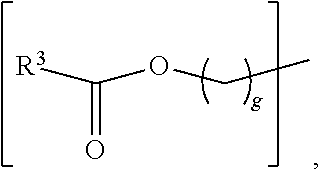


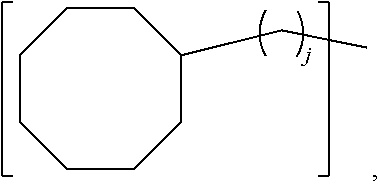


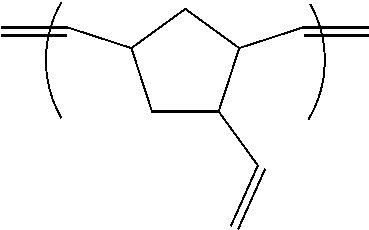

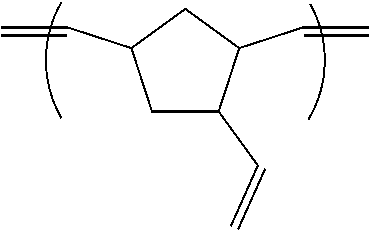







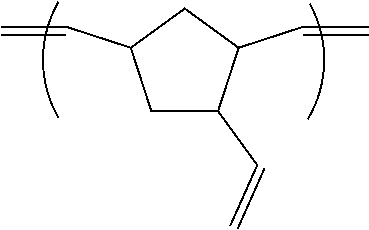



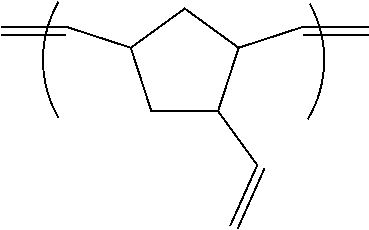


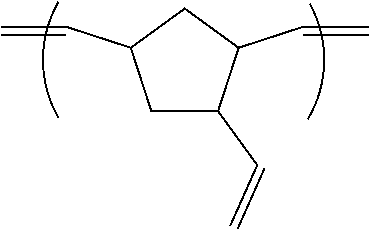




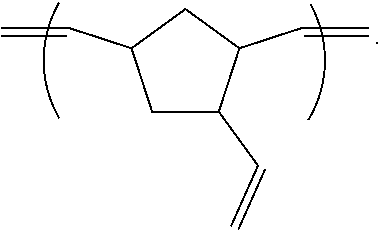







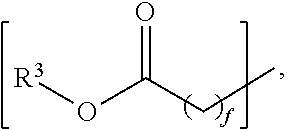




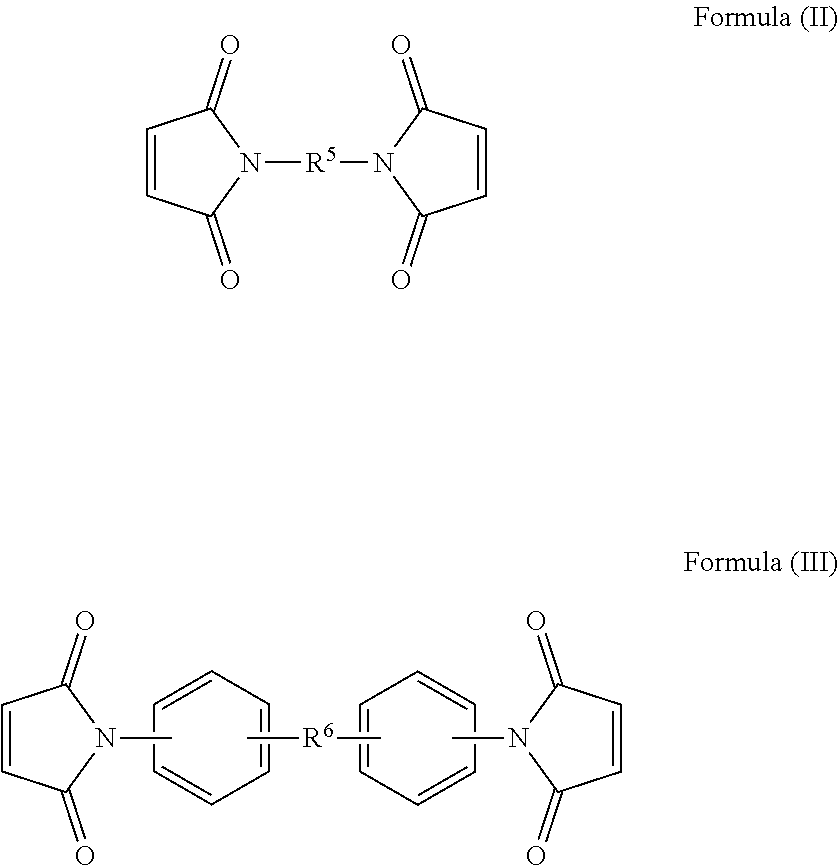
XML
uspto.report is an independent third-party trademark research tool that is not affiliated, endorsed, or sponsored by the United States Patent and Trademark Office (USPTO) or any other governmental organization. The information provided by uspto.report is based on publicly available data at the time of writing and is intended for informational purposes only.
While we strive to provide accurate and up-to-date information, we do not guarantee the accuracy, completeness, reliability, or suitability of the information displayed on this site. The use of this site is at your own risk. Any reliance you place on such information is therefore strictly at your own risk.
All official trademark data, including owner information, should be verified by visiting the official USPTO website at www.uspto.gov. This site is not intended to replace professional legal advice and should not be used as a substitute for consulting with a legal professional who is knowledgeable about trademark law.